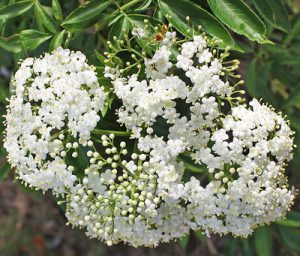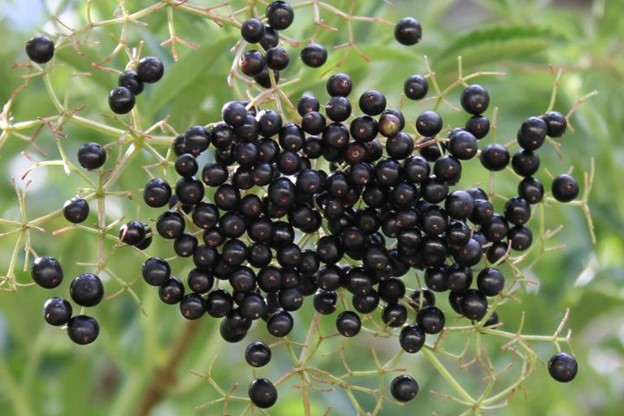The American elderberry (Sambucus nigra ssp. canadensis) is a multi-stemmed bush that produces edible berries and flowers. Little research has been conducted on this crop despite its growing popularity as a preventative treatment for the common cold and for its potential immune boosting properties. Elderberry plants can be found growing in a ditch near you, but at least one farm in Florida is growing elderberries commercially. Hyldemoer farms is conducting research with the University of Florida/IFAS to determine what varieties produce a good crop in Chiefland, FL. However, chill hours received in Chiefland (around 300 chill hours annually) differ slightly from those received annually in the Panhandle (around 500 chill hours annually). Therefore, variety recommendations will be different for our area.
–
Variety Selection and Propagation
Elderberry can be found growing wild throughout the Southeastern United States. Plants thrive in moist areas along roadsides and rivers. At this time, no varieties have been developed specifically for the Florida Panhandle, but researchers from the University of Florida recommended trying varieties developed for the Midwest. ‘Bob Gordon‘ and ‘Wyldewood‘ are two varieties developed by the University of Missouri that show promise in North Florida.
At least two different varieties should be grown to improve pollination and increase crop yield. You may choose to propagate your own plants. In this case, hardwood cuttings from dormant plants are the cheapest and easiest way to propagate, but softwood cuttings can be taken from new growth in early spring. Plants can also be started from root cuttings or from seed, however plants propagated by seed will be highly variable in their growth habit and fruit production.
–
Fertility
Nitrogen (N) should not be applied at planting. Apply 10 lbs. of nitrogen four to eight weeks after planting. Mature plants require roughly 60 to 80 lbs. of nitrogen per year. Phosphorus (P) and potassium (K) should be applied per soil sample recommendations.
–
Pruning
Pruning should be done in January or early-February. Two pruning methods are practiced commercially. One technique is to remove all dead, diseased, or damaged stems, to remove all three-year-old and older wood, and tipping back weaker stems to stronger wood. The second technique is cutting entire plants to the ground. This method slightly reduces yield, but requires less thinking and time.
–
Irrigation
Elderberries require between one and two inches of water per week. Drip irrigation is recommended to conserve water and help reduce disease pressure. Mulch helps conserve soil moisture and reduces and/or slows weed germination. Some growers use black plastic mulch or ground cloth to suppress weeds, but plant holes in the plastic and cloth should be large enough to accommodate new shoots that arise from the crown and roots.
–
Pest Management
Eriophyid mites are microscopic mites that distort developing leaves of elderberries. The best control strategy for this pest is to gather and remove pruned branches from the growing area. Japanese beetles feed on leaves, blossoms, and developing fruit and should be controlled at the onset of infestation. The elderberry sawfly can defoliate an entire crop quickly. The larva of this fly resemble caterpillars, so it is important that chemical controls are selected accordingly. The spotted wing drosophila, which is a common pest of blueberries, can also cause harm to an elderberry crop. Traps and fruit sampling should be implemented to monitor for this insect.
–
Harvest
Elderberry flowers are arranged on cymes, so the fruit are bunched together like grapes. When berries are ripe in mid-to-late summer, entire cymes should be cut from plants for harvest. It is difficult to remove individual berries from the cymes when fresh, but entire cymes can be frozen before berry removal to reduce juice loss.
Elderberry is a potential crop for the back forty of your property or for personal use. Like cherries and peaches, elderberry seeds contain compounds that can convert to cyanide when ingested. This is important to keep in mind when handling and processing fruit. Elderberry leaves, stems, roots, flowers, and fruit are toxic to livestock. For more information on elderberry production, please refer to the University of Missouri’s publication “Growing & Marketing Elderberries in Missouri” and Iowa State’s article “Agroforestry on the Farm: Elderberry”.
- Santa Rosa Citrus Production Workshop –March 7 - February 23, 2024
- Hosting an On Farm Agritourism Event: Helpful Tips - February 16, 2024
- AFVGA Annual Conference & Trade Show – February 14-16 - December 8, 2023


